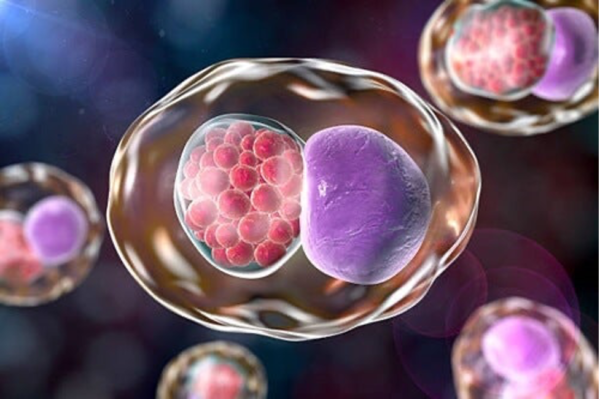Understanding Chlamydia: Symptoms and Treatment


Written and verified by the psychologist Valeria Sabater
Chlamydia or chlamydia trachomatis is one of the most common sexually transmitted diseases in humans. However, understanding chlamydia isn’t as simple as it might seem. The main problem with this infection is that it usually doesn’t cause symptoms. Consequently, people can have it and not even know it. This results in an extremely risky situation, as they can then pass it on to their sexual partners.
Most people have heard of the term chlamydia. However, as is usually the case with sexual conditions, you’re left with a basic idea but no real in-depth information. And chlamydia isn’t just another infection. In many cases, it can cause infertility or pelvic inflammatory disease in women.
Chlamydia affects men as well, and they can also become infertile and develop serious genital infections. It’s certainly not an inconsequential disease. Furthermore, it can sometimes be resistant to treatment. However, discussing sexually transmitted diseases is always a delicate matter, even though they can have serious life-changing consequences.
According to data from a study published in The Lancet by Dr. Nicola Lowh, almost ten million people test positive for chlamydia each year in Europe alone. Young people under 25 are the most affected. Using a condom can prevent many infections. However, doctors stress that this isn’t 100 percent effective.
Children of mothers with Chlamydia trachomatis may develop conjunctivitis. Furthermore, twenty percent of these babies are at risk of neonatal pneumonia.

Understanding chlamydia
Chlamydia trachomatis is an intracellular bacterium that only affects humans. There are fifteen serotypes and each of them can cause a different disease, dependent upon the strain. In addition, this bacterium has two kinds of biovars or basic variant:
- Lymphogranuloma venereum (LGV) which causes systemic diseases.
- Trachoma biovar. It produces arthritis, pneumonia, neonatal conjunctivitis, etc.
Both men and women can be affected by chlamydia. In women, the bacterium lodges in the cervix, rectum, or throat. In men, it inhabits the urethra, rectum, and throat.
How do you catch chlamydia?
Chlamydia is usually transmitted sexually. Infection occurs through genital secretions, mucous membranes of the oropharynx, and the anus. Consequently, condoms can’t completely prevent this type of STD. The illness is also transmitted by oral sex.
Furthermore, a mother with chlamydia can transmit the disease to her baby when they pass through the birth canal.
You can’t get chlamydia by a kiss, a caress, or a hug. Neither can you get it by sharing the same glass, touching the same things, or using the same bathroom, etc.

Understanding chlamydia: symptoms
As we mentioned above, the problem with this sexually transmitted disease is that it often produces no symptoms. However, you can sometimes suffer symptoms from it that you might think are due to something else.
Symptoms of chlamydia in women
It’s known that about seventy percent of women have hardly any symptoms. However, some women suffer from:
- Painful urination.
- Pain during sex.
- Abnormal vaginal discharge with an intense odor-
- Symptoms associated with pelvic inflammatory disease (pain in the abdomen, hips, and pelvis).
- Inflammation of the liver.
Symptoms of chlamydia in men
About thirty percent of men have hardly any symptoms. The rest may suffer from:
- Painful urination.
- Penis and anus secretions.
- Pain in the rectum and testicle sensitivity.
Diagnosis
If you’ve had a risky sexual encounter (for example, unprotected sex), you should get tested for STDs. You should also make sure to visit your doctor.
If a medical specialist suspects that a female patient has chlamydia, they’ll take a sample of uterine cervix mucosa. If a man is presenting symptoms, they’ll take a swab of the urethra, oropharynx, and anus. They’ll then send the samples to be analyzed. The results are always reliable, and the specialist will recommend treatment.
Treatment for chlamydia
Generally, the treatment for chlamydia is pretty simple: antibiotics. These can either be in a single dose or a week’s treatment. Specialists also recommend treating all sexual partners from the last sixty days, whether or not they have any symptoms.
Understanding chlamydia: prevention
No vaccine protects against chlamydia. You have to be responsible and practice safe sex in order to keep yourself protected from STDs. You should always consider the following preventative measures:
- Use condoms correctly.
- Remember you can also get chlamydia through oral sex.
- Wash your sex toys, as they could be an obvious source of transmission.
Finally, remember to have regular check-ups. With prevention and early detection, you’ll be able to treat any potential problems, as well as leading a healthy and satisfying sex life.
All cited sources were thoroughly reviewed by our team to ensure their quality, reliability, currency, and validity. The bibliography of this article was considered reliable and of academic or scientific accuracy.
- Bahamonde, LG (2015). Clamidia En Practical Handbook of Microbiology, tercera edición (pp. 567–578). Prensa CRC. https://doi.org/10.1201/b17871
- Brunham, RC, y Rey-Ladino, J. (2005, febrero). Inmunología de la infección por clamidia: implicaciones para una vacuna contra la clamidia trachomatis. La naturaleza revisa la inmunología . https://doi.org/10.1038/nri1551
- Fan, H., y Zhong, G. (2014). Chlamydia trachomatis. En Molecular Medical Microbiology: Segunda edición (Vol. 3, pp. 1449–1469). Elsevier Ltd. https://doi.org/10.1016/B978-0-12-397169-2.00081-0
This text is provided for informational purposes only and does not replace consultation with a professional. If in doubt, consult your specialist.








